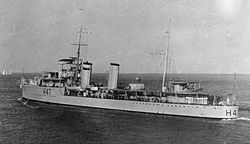HMS Blanche (H47)
|
||||||||||||||||||||||
|
||||||||||||||||||||||
|
||||||||||||||||||||||
|
||||||||||||||||||||||
HMS Blanche (H47) was a destroyer of the B-Class of the British Royal Navy . The Blanche was the first destroyer of the Royal Navy, which sank during the Second World War by enemy action when it ran into a mine on the night of November 12th to 13th, 1939 , which had been laid a few hours earlier by German destroyers.
History of the destroyer
On March 4, 1929, the Hawthorn Leslie shipyard in Hebburn near Newcastle upon Tyne was commissioned to manufacture two ships of the second class destroyer of the Royal Navy, which were built after the end of the First World War . In 1928 the shipyard had already received construction contracts for two destroyers of the previous A-class . The keel of the Blanche as the second ship of the follow-up order took place on July 29, 1929, just three weeks after the sister ship Boadicea, which was being built at the shipyard . The Royal Navy's tenth Blanche was launched on May 29, 1930 and entered service on February 19, 1931 as the first B-class destroyer.
The blanche had a standard displacement of 1,360 ts and 1,780 ts when fully equipped. Like her sister ships, she was 323 ft over all , had a width of 32.25 ft and a draft of 12.25 ft. She was propelled by two shafts of Parsons geared turbines , which achieved a maximum output of 35,500 hp, and the destroyer one Maximum speed of 35.25 knots (kn) made possible. The steam for the turbines was generated in three Admirality 3-drum boilers . The bunker stock of up to 390 tn.l. Heating oil gave the destroyer a range of up to 4,800 nautical miles at 15 kn.
The destroyer was armed with four individual 120 mm L / 45 Mk.IX guns . To protect against aircraft, two 40 mm “pompom” guns were installed on a platform between the funnels on the Blanche . For this purpose, the destroyer had two quadruple sets of 21-inch torpedo tubes on deck. To fight submarines, the destroyer carried 20 depth charges , which were deployed with two depth charge launchers and a drop rail. The depth of the depth charges was increased to 35 after the war began. The crew of the ship consisted of 134 men and was increased to 142 when the war broke out.
Mission history
The Blanche and her sister ships were first assigned to the “4th Destroyer Flotilla” in the Mediterranean Fleet . Since the British Mediterranean fleet mostly received the latest destroyers, the flotilla was moved to the Home Fleet in late 1936 . Because of the increasing political tension, the Blanche moved to Gibraltar in 1937 and participated again in the so-called neutrality patrols off the Spanish coast in the western Mediterranean because of the Spanish civil war . On March 6, 1938, she was attacked by five Spanish national planes that did not score a hit on the destroyer. After six months of service off Spain, the destroyer returned home in 1938 and, like the sister ships, was assigned to the reserve fleet because a large number of modern destroyers had been put into service in the meantime.
War effort
At the beginning of the war in 1939, the destroyer was reactivated and assigned to the "19th Destroyer Flotilla". The flotilla, stationed at the eastern exit of the English Channel , secured convoys and warships in the British coastal waters, patrolled the Strait of Dover and ensured the transfer of British troops to mainland Europe.
On the night of November 12th to 13th, 1939, the Blanche ran the mine cruiser Adventure together with the sister ship Basilisk . In the Thames estuary , the mine got into a mine barrier that had been laid a few hours earlier by the German destroyers Karl Galster , Hans Lüdemann , Hermann Künne and Wilhelm Heidkamp . When the securing destroyers tried to lead the damaged minelayer out of the minefield, Blanche also ran into a mine. The ship sank on the morning of November 13, in tow of the tug Fabia at 51 ° 29 ' N , 1 ° 30' O . The sinking of the Blanche left one dead and twelve crew members injured.
HMS Blanche was the Royal Navy's first destroyer to sink through enemy action during World War II.
literature
- Norman Friedman: British Destroyers From Earliest Days to the Second World War. Naval Institute Press, Annapolis MD 2009, ISBN 978-1-59114-081-8 .
- MJ Whitley: Destroyers of World War Two. Arms and Armor Press, London 1988, ISBN 0-85368-910-5 .
Web links
- Blanche 1931 on tynebuiltships.co
- HMS BLANCHE (H 47) - B-class Destroyer on naval-history.net
- HMS Blanche (H 47) on uboat.net
- Site to the downfall of Blanche (English)
- Chronicle of naval warfare 1939–1945
Individual evidence
- ^ MJ Whitley: Destroyers of World War Two. Arms and Armor Press, London 1988, ISBN 0-85368-910-5 , p. 99
- ^ Norman Friedman: British Destroyers From Earliest Days to the Second World War. Naval Institute Press, Annapolis MD 2009, ISBN 978-1-59114-081-8 , p. 298
- ^ Rohwer: Sea War . 12-13 November 1939, North Sea

